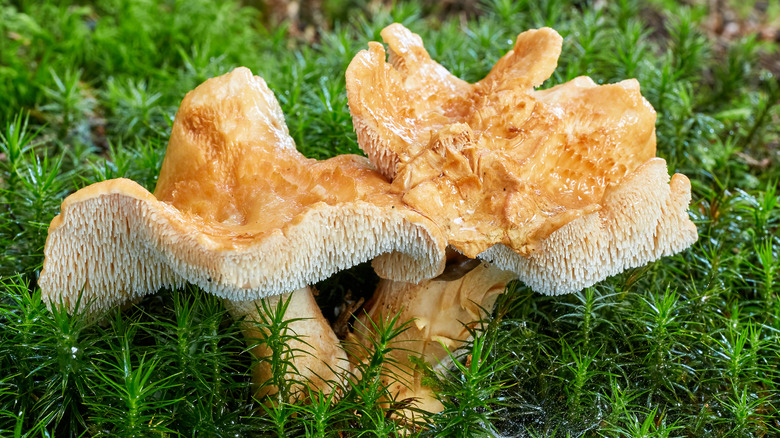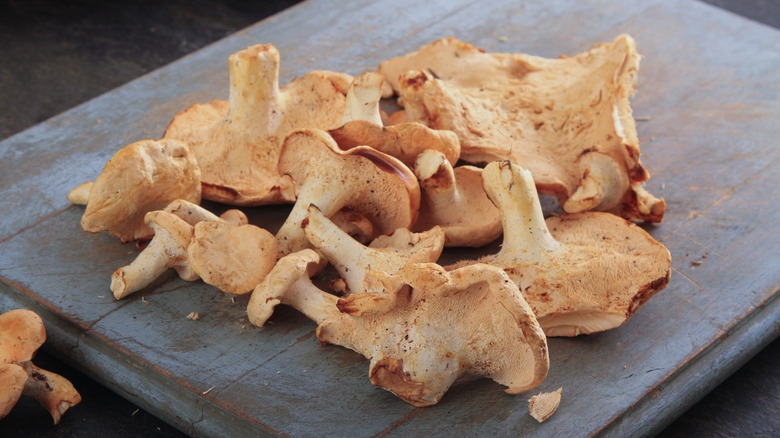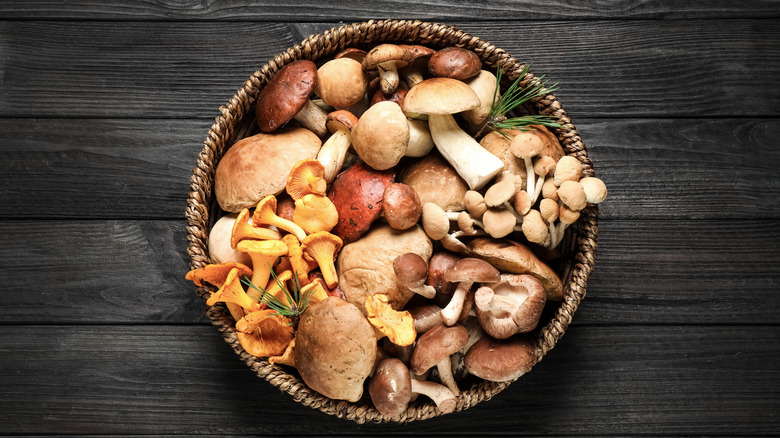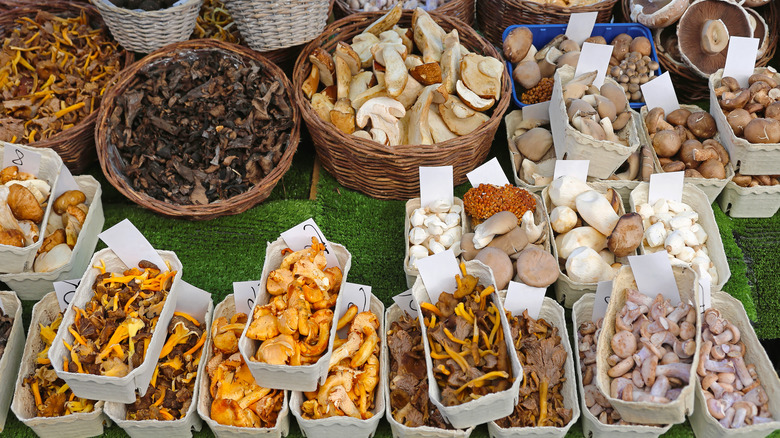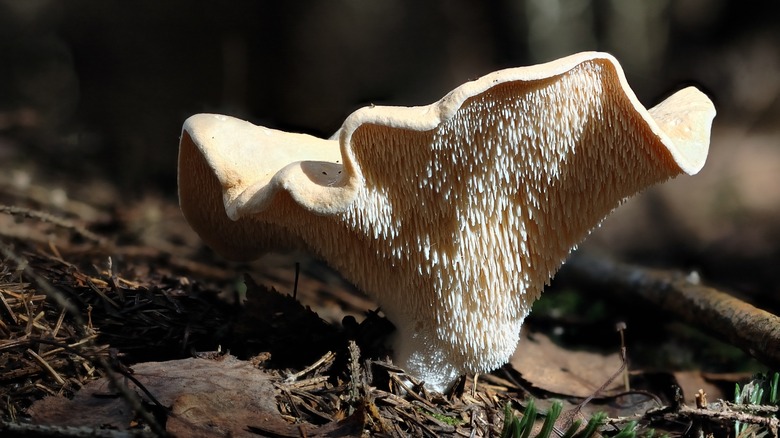What Makes Hedgehog Mushrooms Unique
Hedgehog mushrooms — also known as sweet tooth mushrooms, wood hedgehog mushrooms, or pieds de mouton in France — are a popular group of edible fungi. However, of the several variations, including the smaller belly button mushrooms, GroCycle declares Hydnum repandum as the true hedgehog. Like other mushrooms, hedgehog mushrooms have a cute shape characterized by a small stem and large cap. But just underneath their smooth, cream-colored caps, hedgehog mushrooms hide a distinguishing texture.
According to Galloway Wild Foods, 90% of edible mushrooms, such as portobellos, have dark gill-looking lines underneath their caps. However, so do the majority of poisonous ones. The underside of a hedgehog mushroom's cap, on the other hand, sports short, vertical hanging spines — similar to the back of a hedgehog, for which it got its name. For foragers in the wild, this singular differentiation is what makes hedgehog mushrooms so unique, assuring them that they are, in fact, safe to eat.
What hedgehog mushrooms taste like and how to cook with them
The Mushroom Forager compares the flavor of hedgehog mushrooms to that of the chanterelle — one of the most well-known mushrooms among chefs and foodies, per Wild Edible. Hedgehog mushrooms provide the same sweet, apricot flavor that the chanterelles are cherished for, only with a slightly earthier, nuttier taste and peppery finish (via GroCycle). For this reason, you'll commonly see them prepared in similar ways.
When cooking with hedgehog mushrooms, one thing is for sure: You won't need to remove the gills. However, Galloway Wild Foods does indicate that some people do remove hedgehogs' spines, but that's completely up to you. Every part of a hedgehog mushroom is edible — from the stems to the caps, including those little spines. The Spruce Eats recommends preparing them as you would any other mushroom, preferably sautéed while they're still young and firm. One tip is to do so in batches in a single layer covering the pan, so as not to stew them.
Hedgehog mushrooms are good on their own (where their wild mushroom flavor gets to shine), tossed into pasta, used as a topping to your pizza, or even pickled.
Nutritional information for hedgehog mushrooms
Mushrooms have earned a name in the health food world for good reason. According to Healthline, they've been used in Eastern medicine for thousands of years. From cancer-fighting chaga and turkey tail mushrooms to brain-boosting lion's mane and stress-reducing reishi mushrooms, they offer a long list of different benefits. These days, you can reap the magic benefits of mushrooms in your morning coffee and cappuccinos, or, as they're better known, "chagaccinos" (per Renude). However, when it comes to consuming hedgehog mushrooms, the benefits are mainly nutritional.
A 2009 study published in the journal Food Chemistry evaluated the chemical composition and nutritional value of many species of wild-growing mushrooms, including hedgehogs. They found that, when dried, hedgehog mushrooms are composed of 20% protein, 4% fat, and 56% carbohydrates. Additionally, in a 100-gram amount, hedgehog mushrooms deliver high amounts of dietary minerals, including copper, manganese, and valuable omega-6 and 9 fatty acids, including oleic and linoleic acid. Hedgehog mushrooms are particularly beneficial to your immune system, thanks to their high vitamin B content (via Northwest Wild Foods).
Where to get hedgehog mushrooms
Hedgehog mushrooms are a mycorrhizal species, which, according to GroCycle, means that they grow symbiotically with trees. By connecting to their roots, mushrooms help to draw important minerals and water into the tree, and vice versa. It's an important relationship, and although they are technically fungi, the presence of mushrooms on forest grounds is a symbol of a healthy and balanced ecosystem (per Sempervirens Fund) — something that cannot possibly be recreated anywhere else. For this reason, hedgehog mushrooms can't be cultivated and can only be foraged in the wild.
So, if you're hoping to get your hands on a batch of hedgehog mushrooms, your typical grocery store most likely isn't the place to go. Your best bet is to get them from a forager, a farmers market, or a specialty grocery store whenever they're in season in your area (per GroCycle). This can vary depending on where you live — hedgehog mushrooms appear anywhere from mid-summer to late winter, appearing abundantly in the western U.S. from October to February and in the eastern U.S. from July to November. Because they're so easily identifiable, hedgehog mushrooms are the perfect mushroom for beginner foragers.
Identifying hedgehog mushrooms
According to The Mushroom Forager, when it comes to foraging mushrooms, hedgehogs are the most foolproof. Hedgehog mushrooms have caps that range in color from salmon pink to cream to yellow and grow in sizes from four to 20 centimeters in diameter. Still, their spine-y undersides are what distinguishes them from the rest (via Galloway Wild Foods). They are mycorrhizal with beech, birch, scots pine, spruce, and western hemlock trees, so you can find them growing around them. Their aromas are slightly sweet and somewhat fruity, similar to the chanterelle — but without the potentially poisonous look-a-likes.
Though chanterelles are delicious, foraging them is a risky business for beginners. They are easily mistaken for poisonous jack-o'-lantern mushrooms, which the Missouri Department of Conservation says won't kill you but will give you tremendous stomach upset. Hedgehog mushrooms, on the other hand, provide a similar texture and flavor without the risk. GroCycle only identifies two potential look-a-likes: the drab tooth mushroom and the scaly hedgehog mushroom, neither of which are poisonous. Once you do find a batch, not only do you not have to worry about potentially being poisoned, but you can return to the same place each year, as they will continue to re-appear each season.
